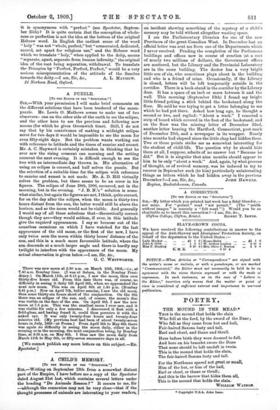A PUZZLE.
[To THE Enrron oy THE "SpacraToR."1
Si,—With your permission I will make brief comments on the different solutions that have been tendered of the moon- puzzle. Mr. Lewis 0. Mathews seems to make use of two observers : one on the other side of the earth to see the eclipse, and the other here to see the previous and following new moons (for which he gives Greenwich time). Still, I do not say that by his contrivance of making a midnight eclipse serve for two days it would be impossible to see the moon for even fifty-eight days. But the problem wants working out with reference to latitude and the times of sunrise and sunset. Mr. A. C. Hayward is certainly mistaken in thinking that he ever saw the rising crescent one morning and the setting crescent the next evening. It is difficult enough to see the two with an intermediate day thrown in. His alternative of using an eclipse is correct, and half solves the puzzle. But the selection of a suitable time for the eclipse with reference to sunrise and sunset is not made. Mr. A. D. Hill virtually solves the problem, but there seems to be an error in his figures. The eclipse of June 28th, 1908, occurred, not in the morning, but in the evening. "J. B. N.'s " solution is some- what similar, but again the figures are not, I think, quite correct, for on the day after the eclipse, when the moon is thirty-two hours distant from the sun, the latter would still be above the horizon, and so the inoon would not be visible. And generally I would say of all these solutions that—theoretically correct though they are—they would seldom, if ever, in this latitude give the required appearances. I say so because out of the ountless occasions on which I have watched for the last appearance of the old moon, or the first of the new, I have only twice seen the moon within thirty hours' distance of the sun, and this in a much more favourable latitude, where the sun descends at a much larger angle and there is hardly any twilight to interfere with the appearance of the moon. My actual observation is given below.—I am, Sir, &c.,
, There was newnioon at 2.50 a.m. on March 10th, 1902,—i.e., at 7.40 a.m. Bombay time. . (I was at Satara, in the Bombay Presi- dency.) On March 11th; at 6.15 p.m., I saw the moon, then over thirty-five hours old. From this date there was, of course, no difficulty in seeing it daily till April 6th, when we approached the next new moon. This was on April 8th at 1.50 p.m. (Bombay 6.41 p.m.) Now on April 7th, before sunrise, I saw the old Moon, then some thirty-six hours short of the conjunction. On the 8th there was an eclipse of the sun, and, of course, the moon's disc was visible on the face of the sun. On April 9th I saw the new moon at 7.5 p.m. This was the smallest moon I ever saw, and it was visible for only a few minutes. I discovered it first with a field-glass, and having found it,- could then perceive it with the naked eye. It was only twenty-four - hours and twenty-four minutes old. (My previous best had been of about twenty-seven hours in July, 1893—at Poona.) From April 9th to May 6th there was again no difficulty in seeing the moon daily, either in the evening or in the morning, the next conjunction being, by Bombay time, at 3.35 HAM on May 8th. I thus saw the moon daily from March 11th to May 6th, or fifty-seven successive days in all.
[We cannot publish any more letters on this subject. —En. $pectator.]


























































 Previous page
Previous page